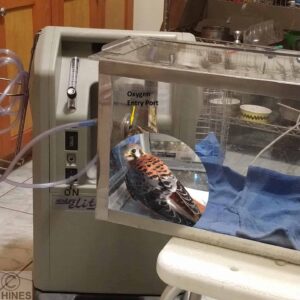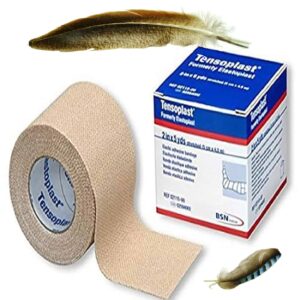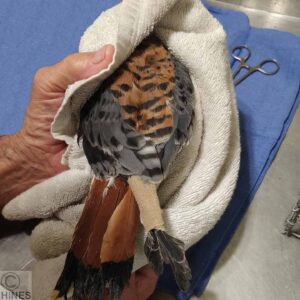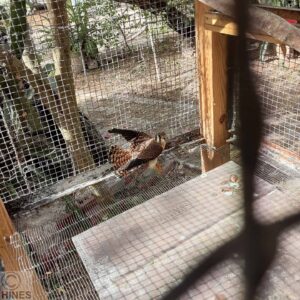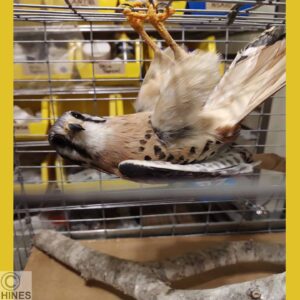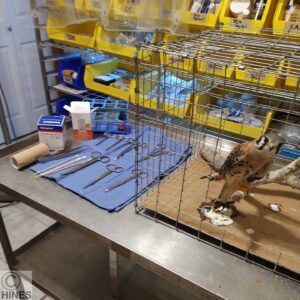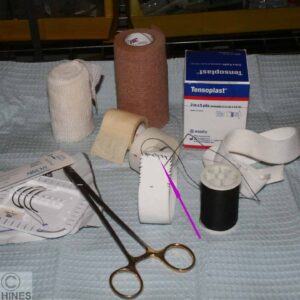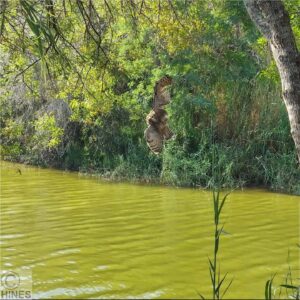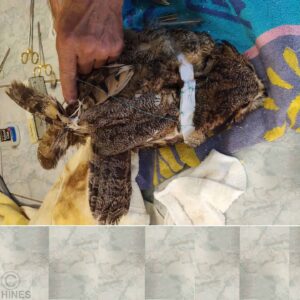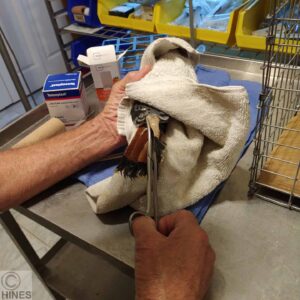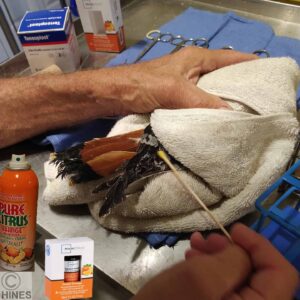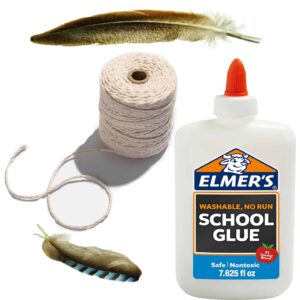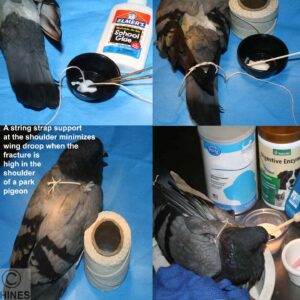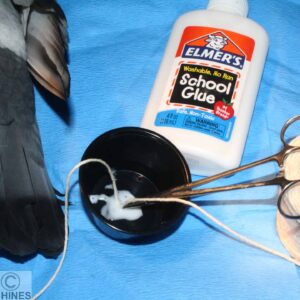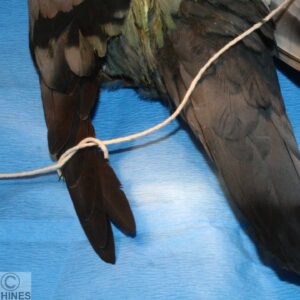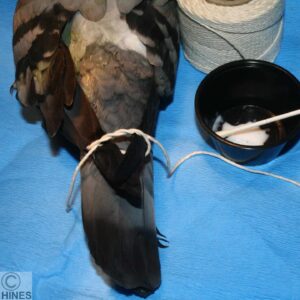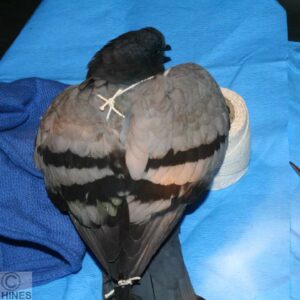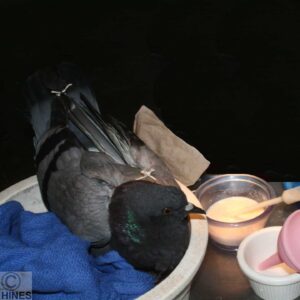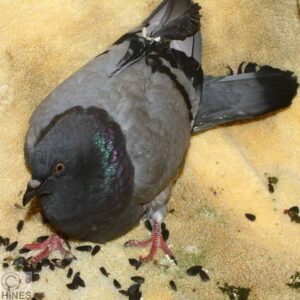Two Simple Ways To Repair Bird Wing And Shoulder Injuries
Applied Tape, or String And Glue
Splinting Wing Injuries With Tape Supports
I live on the major constriction point of the Central North American Highway. Migrating birds passing through often collide with tall buildings – particularly since Elon Must chose to locate his rocket port ~ 20 mi (32 km) from my house in Brownsville, Texas. (see here) The little kestrel above was one of those casualties. Whenever gasping, tail bobbing, birds are brought to me, I place them in an oxygen box hooked to a portable oxygen generator. You can see it in the header photo. I only have one, so if you have a spare one let me know. Most are gasping and pumping their tails due to internal bleeding. Some recover, some do not. All their other issues are secondary to a bird’s need for oxygen. The photo above is a composite as I was alone and had no time for a photo shoot. The kestrel stayed in the box the entire night. You do not want to remove them too early.
The next day she was breathing normally. But at that time, it was apparent that she was carrying her left wing lower than her right wing. She had no wing or other detectable fractures the previous day. So I assumed she had sustained a coracoid or shoulder ligament injury. They are common, always just one wing, and they are not detectable on x-rays. But with sufficient stabilization, many of those injuries will heal, given enough time. I have seen similar injuries in birds like this Great Horned Owl, trapped in fishing line and dangling from her wing for several days. (see here) That owl is much improved now after 3 months of treatment. I hope to release her soon. (see here) This Kriders red tail Hawks came in with the same problem. (see here)
This particular kestrel was unlike any I had treated before. Once it wings were taped, It was absolutely fearless of humans. Perhaps it was some far away rehabbers release on her way south for the winter. Perhaps the collision had made her forget who she was. I do not know. After coming inside for treatment and having her wings taped, she preferred to hang upside down while observing her roommate, a crippled parrot named Charlie Charlie arrived for hip surgery, but his previous owners never picked him up.
Tensoplast® brand is my favorite tape for this use. It stretches and leaves very little sticky residue on feathers after it has been on for two or three weeks. Ordinary hospital tape and the kling™ bandage you see in the second photo above can be used as well. however, it must be sewn on at the end to keep it from unraveling over time. I use silk suture to do that, but you can use ordinary sewing thread. Don’t use any material that is apt to produce threads – such as gauze. Loose threads can wrap around legs, wings and necks, providing considerable danger. I generally leave the tape on for 3–4 weeks before I remove it. It might take considerably less time to heal if the bird is still growing. The third and fourth photos above are of a great horned owl, whose wing became tangled in fishing line. It hung from a branch for a number of days before being delivered to me. As in the kestrel, elastic bandages need to be sewn in place to feather shafts to keep them from shifting during recovery.
I have always had trouble removing tape glue from feathers without damaging them. Recently, a local SpaceX employee suggested I use 3M™ Citrus-Based Industrial Cleaner to remove the tape residue from an owl. (read here) It comes in an aerosol spray can: 
Splinting Wing Injuries With Ordinary Cotton Twine And School Glue
People drop off a large number of injured pigeons. But this technique works well on all birds other than parrots, and perhaps other birds that can gnaw off string. Those types of birds need considerably more severe restraint to keep them from injuring themselves or removing devices. (see here)
I take the first four (the longest) flight feathers on the uninjured wing and knot the packing twine after it has been moistened with school glue around them. Two throws of the knot, rather than the one throw shown in the photo above will clench the knot tighter. But it is also more likely to permanently injure the feather shaft.
Then I include the same feathers on the drooping wing in the knot – being sure that the injured wing rests above the uninjured wing forming an upside-down victory salute. They should be perfectly symmetrical, which often requires a second person to temporarily support the shoulders.
For some birds, the primary feather supports are sufficient. For those with more severe shoulder injuries, a second string support over the shoulders is helpful. This particular pigeon never regained normal flight. But it could maneuver well enough to live in a local park population of pigeons. Had it not received treatment, it injured wing would have dragged on the ground and the bird would have eventually died.
The last photo is the pigeon after its shoulder support was removed. I had used no glue to hold it in place, so it came off with a few scissor snips. I let the tail support stay on for another week or so. When you remove that glued twine, be sure to first soak the area with warm water to liquify the glue. Then it comes off with tweezers or forceps with no feather damage.
There are more sophisticated methods that I use when necessary. Read about some of them here & here.
You are on the Vetspace animal health website
Visiting the products that you see displayed on this website help pay the cost of keeping these articles on the Internet.

